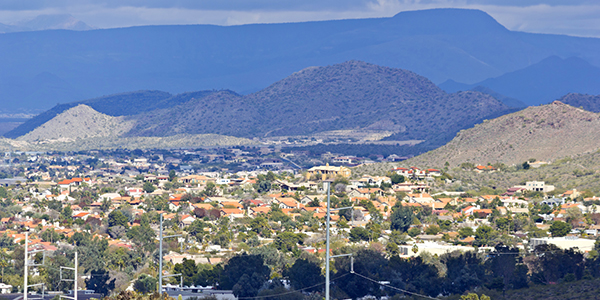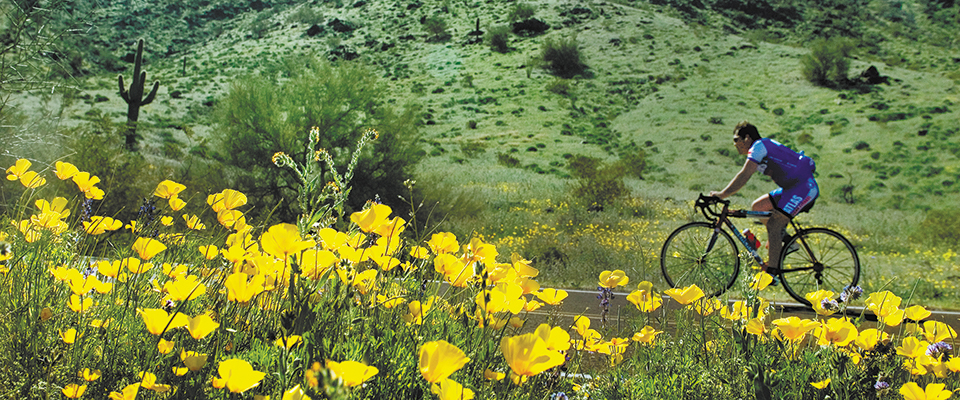Spotlight: Valley of the Sun
This region shines with an array of fun-filled attractions
Veteran snowbirds and seasoned Southwesterners know that there’s lots to do in the “Valley of the Sun,” the 20 or so communities that make up this desert valley destination. The valley offers a multitude of activities for visitors from all walks of life. Scattered among the bigger cities of Phoenix, Glendale, Scottsdale and Mesa, travelers will find charming small communities with as much to offer as their more bustling neighbors.
Go back to the beginning and see what the valley’s earliest inhabitants left behind. Deer Valley Rock Art Center near Sun City is operated by Arizona State University’s Department of Anthropology and is dedicated to preserving more than 1,500 petroglyphs—some of which were created as long as 10,000 years ago by pre-Archaic, Archaic, Hohokam and Patayan people.
Arizona’s stunning natural beauty is the star of Wickenburg in the High Sonoran Desert. Resting adjacent to the mostly underground Hassayampa River in Wickenburg, kids will choose their own adventure at the Arthur L. Johnson Visitor Center. The interactive displays inside are just the start; outside, where the river comes to the surface, a diverse ecological world awaits visitors. Explore the Hassayampa River Preserve on a trail walk, either self-guided or led by a knowledgeable docent. Keen observers will spot lizards like the rare Gilbert’s skink darting in the underbrush.
When the sun sets in the west, the town of Carefree in the east is the place to be. The night sky reveals its starry splendor over the granite hills and, if you prefer some assistance in spotting Ursa Minor, local stargazing tours are offered in Carefree as well as other areas of the valley.

Getty Images/iStockphoto
Forest Fun
The rugged forests that shoulder the valley to the north are havens for lovers of the great outdoors. McDowell Mountain Regional Park offers several outdoor programs when weather permits, including sunset hikes that culminate under the light of the full moon. There are more than 40 miles of multi-use trails suited for mountain biking, horseback riding and hiking. The park’s nature center hosts several activities for young visitors, too. Kids can become junior rangers, engage in nature-craft activities and even watch the center’s resident reptiles enjoy a noon meal. Spot Javelina, coyotes and other wildlife as you explore.
Despite Arizona’s arid reputation, fishermen will be pleased to learn that rainbow trout can be found year-round north of Mesa in the Salt River, below Saguaro Lake, where the water stays a cool 65 degrees. Bass fishing in the valley is equally challenging and satisfying. Apache Lake, along with Saguaro and Canyon Lake are home to robust populations of largemouth bass and yellow bass. Each lake provides space for shoreline fishing as well as dock and ramp access.
Golf is a major draw for avid players and fans of the sport; besides hosting a handful of professional tours, the region boasts nearly 200 courses, including many municipal greens and high-end courses that are open daily. Whether you hit a few at Superstition Springs Golf Club in the East, or at Dove Valley Ranch in the West, there’s a course for every skill level.
Journey to the Past
Escape the heat of the valley with a trip into one or more of the area’s great museums. The world of music is captured and displayed at the Musical Instrument Museum in Phoenix. More than a place to see, this tuneful museum is place where visitors can also play instruments from around the globe, such as the Southeast Asian gamelan, and where they can enjoy concerts, workshops and classes.
A quieter museum experience can be found at the Scottsdale Museum of Contemporary Art. Traveling and permanent exhibits showcase the beauty and creativity of everyday objects and elegant pieces.
If the Wild West is what you saddle up for, then visit the Pioneer Living History Museum, west of Cave Creek, where more than 20 preserved structures such as a bakery, cabins and even an opera house help recreate life for settlers in the mid-19th century. In addition to authentic architecture, the museum hosts demonstrations and even battle reenactments. Also offered are self-guided tours of the village and military camps. Check out the restored jailhouse, home to several artifacts including a gun rack, rolltop desk and bunks for inmates.

Getty Images/iStockphoto
Fans of TV westerns need to take in the sights at the Superstition Mountain Museum, where a barn famous for its role in the classic “The Rifleman” now sits alongside other historic pieces, including the Elvis Memorial Chapel—so named for its role in the movie “Charro,” starring Elvis Presley. The museum’s prehistoric Indian exhibit displays Hohokam and Salado artifacts, including bowls, awls, arrowheads, stone hammers, axe heads and shell pendants. Visitors will also see an exhibit dedicated to the legend of the Dutchman’s Lost Mine. In the same vein, gold ore and other stones are on display at the goeological exhibit.
North of Phoenix lies the ruin of a town that was born from gold-rush fever. Stanton was founded as Antelope Station and was the site of large gold deposits discovered in the mid-1860s. Near the turn of the century, Stanton was a bustling town with resident miners and businesses such as a stamp mill, hotel and boarding house. But when the gold ran dry, the town was abandoned. Now visitors can wander through well-preserved buildings that are part of an operating RV park.
For More Information
Greater Phoenix Convention and Visitors Bureau
877-CALLPHX
www.visitphoenix.com







